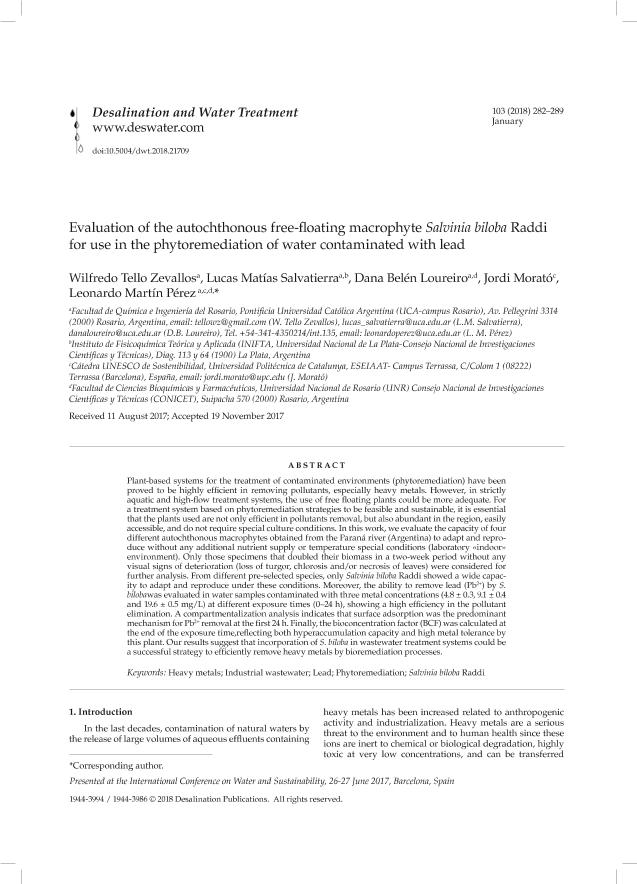Artículo
Evaluation of the autochthonous free-floating macrophyte salvinia biloba raddi for use in the phytoremediation of water contaminated with lead
Zevallos, Wilfredo Tello; Salvatierra, Lucas Matías ; Loureiro, Dana Belén; Morató Farreras, Jordi; Pérez, Leonardo Martín
; Loureiro, Dana Belén; Morató Farreras, Jordi; Pérez, Leonardo Martín
 ; Loureiro, Dana Belén; Morató Farreras, Jordi; Pérez, Leonardo Martín
; Loureiro, Dana Belén; Morató Farreras, Jordi; Pérez, Leonardo Martín
Fecha de publicación:
01/2018
Editorial:
Desalination Publ
Revista:
Desalination and Water Treatment
ISSN:
1944-3994
Idioma:
Inglés
Tipo de recurso:
Artículo publicado
Clasificación temática:
Resumen
Plant-based systems for the treatment of contaminated environments (phytoremediation) have been proved to be highly efficient in removing pollutants, especially heavy metals. However, in strictly aquatic and high-flow treatment systems, the use of free floating plants could be more adequate. For a treatment system based on phytoremediation strategies to be feasible and sustainable, it is essential that the plants used are not only efficient in pollutants removal, but also abundant in the region, easily accessible, and do not require special culture conditions. In this work, we evaluate the capacity of four different autochthonous macrophytes obtained from the Paraná river (Argentina) to adapt and reproduce without any additional nutrient supply or temperature special conditions (laboratory «indoor» environment). Only those specimens that doubled their biomass in a two-week period without any visual signs of deterioration (loss of turgor, chlorosis and/or necrosis of leaves) were considered for further analysis. From different pre-selected species, only Salvinia biloba Raddi showed a wide capacity to adapt and reproduce under these conditions. Moreover, the ability to remove lead (Pb2+) by S. bilobawas evaluated in water samples contaminated with three metal concentrations (4.8 ± 0.3, 9.1 ± 0.4 and 19.6 ± 0.5 mg/L) at different exposure times (0–24 h), showing a high efficiency in the pollutant elimination. A compartmentalization analysis indicates that surface adsorption was the predominant mechanism for Pb2+ removal at the first 24 h. Finally, the bioconcentration factor (BCF) was calculated at the end of the exposure time,reflecting both hyperaccumulation capacity and high metal tolerance by this plant. Our results suggest that incorporation of S. biloba in wastewater treatment systems could be a successful strategy to efficiently remove heavy metals by bioremediation processes.
Archivos asociados
Licencia
Identificadores
Colecciones
Articulos(INIFTA)
Articulos de INST.DE INV.FISICOQUIMICAS TEORICAS Y APLIC.
Articulos de INST.DE INV.FISICOQUIMICAS TEORICAS Y APLIC.
Citación
Zevallos, Wilfredo Tello; Salvatierra, Lucas Matías; Loureiro, Dana Belén; Morató Farreras, Jordi; Pérez, Leonardo Martín; Evaluation of the autochthonous free-floating macrophyte salvinia biloba raddi for use in the phytoremediation of water contaminated with lead; Desalination Publ; Desalination and Water Treatment; 103; 1-2018; 282-289
Compartir
Altmétricas



